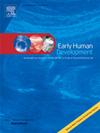婴儿期HINE、Bayley、一般动作和MOS-R的预测效度
IF 2
3区 医学
Q2 OBSTETRICS & GYNECOLOGY
引用次数: 0
摘要
患有先天性畸形需要手术的婴儿发育迟缓的风险更大。需要早期筛查工具来确定哪些婴儿可以从早期干预中受益。本研究旨在探讨一般运动评估(GMA)、运动优化评分-修订(MOS-R)、Hammersmith婴儿神经检查(HINE)和Bayley-III在识别有不良神经发育结局风险的婴儿中的同时预测有效性。方法对95例外科婴儿进行回顾性队列研究。参与者在3个月时使用GMA、MOS-R、HINE和Bayley-III进行评估。使用Bayley-III评估1年的发展情况。通过敏感性、特异性、阳性(PPV)和阴性(NPV)预测值和ROC曲线下面积(AUC), Logistic回归研究了3个月时测量值与发育结局之间的关系。结果各评价指标均与发育有关。3个月时的联合评估没有提高预测价值。MOS-R & lt;23或HINE<;60在1年时识别Bayley-III≥2个结构域延迟的敏感性为>; 70%,而>;排除无危险婴儿的准确率为80%。MOS-R & lt;23 (NPV 0.957)和HINE <;60 (NPV 0.971)与延迟认知显著相关。在手术队列中,3月龄时使用GMA、MOS-R、HINE和Bayley-III的同时预测有效性较低,但所有评估工具均显示与结果相关。HINE和MOS-R可能有助于识别需要认知支持的婴儿。进一步探索早期筛查工具可能有助于确定哪些婴儿将受益于早期干预。本文章由计算机程序翻译,如有差异,请以英文原文为准。
The predictive validity of HINE, Bayley, general movements and MOS-R in infancy
Introduction
Infants born with congenital anomalies requiring surgery are at greater risk of developmental delays. Early screening tools are needed to identify infants who would benefit from early intervention. This study aimed to investigate the concurrent predictive validity of the General Movements Assessment (GMA), Motor Optimality Score – Revised (MOS-R), Hammersmith Infant Neurological Examination (HINE) and Bayley-III in identifying infants at risk of adverse neurodevelopmental outcomes.
Methods
A retrospective cohort study of 95 surgical infants. Participants were assessed at 3 months using the GMA, MOS-R, HINE, and Bayley-III. Development was assessed at 1 year using the Bayley-III. Logistic regression investigated the relationship between measures at 3 months and developmental outcome, using sensitivity, specificity, positive (PPV) and negative (NPV) predictive value and area under the ROC curve (AUC).
Results
All assessments had a relationship with development. Combining assessments at 3 months did not increase predictive value. MOS-R < 23 or HINE<60 had >70 % sensitivity for identifying delays in ≥2 domains of the Bayley-III at 1 year, and > 80 % accuracy in ruling out infants not at risk. MOS-R < 23 (NPV 0.957), and HINE <60 (NPV 0.971) were significantly correlated with delayed cognition.
Discussion
In a surgical cohort, the concurrent predictive validity of the GMA, MOS-R, HINE and Bayley-III, administered at 3 months of age was low, however all assessment tools showed correlations with outcomes. The HINE and MOS-R might help to identify infants who need support with cognition. Further exploration of early screening tools may help to identify infants who would benefit from early intervention.
求助全文
通过发布文献求助,成功后即可免费获取论文全文。
去求助
来源期刊

Early human development
医学-妇产科学
CiteScore
4.40
自引率
4.00%
发文量
100
审稿时长
46 days
期刊介绍:
Established as an authoritative, highly cited voice on early human development, Early Human Development provides a unique opportunity for researchers and clinicians to bridge the communication gap between disciplines. Creating a forum for the productive exchange of ideas concerning early human growth and development, the journal publishes original research and clinical papers with particular emphasis on the continuum between fetal life and the perinatal period; aspects of postnatal growth influenced by early events; and the safeguarding of the quality of human survival.
The first comprehensive and interdisciplinary journal in this area of growing importance, Early Human Development offers pertinent contributions to the following subject areas:
Fetology; perinatology; pediatrics; growth and development; obstetrics; reproduction and fertility; epidemiology; behavioural sciences; nutrition and metabolism; teratology; neurology; brain biology; developmental psychology and screening.
 求助内容:
求助内容: 应助结果提醒方式:
应助结果提醒方式:


